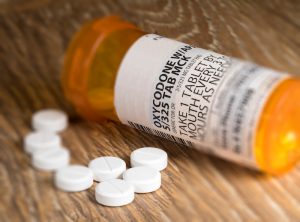Oxycodone is an opioid used in the treatment of severe pain. Some of the situations that could prompt a prescription for Oxycodone include pain from surgery, cancer, or severe injury. The drug is also used for treating chronic pain in patients who don’t respond to weaker painkillers such as aspirin, paracetamol, and ibuprofen.
Other terms used to describe Oxycodone include Oxycontin and Oxynorm.
Various Forms of Oxycodone
Oxycodone is available in multiple forms:
 Capsules. The capsules are available in quantities of 10mg, 5mg, and 20mg. The milligrams denote the amount of Oxycodone found in the pills.
Capsules. The capsules are available in quantities of 10mg, 5mg, and 20mg. The milligrams denote the amount of Oxycodone found in the pills.- Tablets. These are slow releasing medicines and can contain 20mg, 5 mg, 20mg, 15mg,40 mg, 60mg, 120mg or 80mg of oxycodone.
- Liquid. The liquid form of Oxycodone is available in 5mg, 10mg, 5ml, and 1ml of liquid Oxycodone.
When it’s in liquid form, capsules, or injections, the drug works faster and is therefore used to manage pain that doesn’t last long or help find the correct dose once someone is introduced to Oxycodone by a doctor.
On the other hand, the tablets are slow releasing, and it can take between 12 to 24 hours before you feel the effect of the drugs. While the tablets are slowly released into the system, their effects last longer, making them ideal for managing chronic pain.
In some cases, a physician will prescribe both fast-acting and slow-acting Oxycodone meds to a patient.
How soon will I feel the Effects after taking Oxycodone?
 Simple forms of Oxycodone are taken every four to six hours, but the slow-release forms of the drug are administered every twelve hours. Upon ingestion, pain relief will be experienced within 10 to 15 minutes. Most individuals experience a peak of the drug after 30 minutes to an hour after ingestion.
Simple forms of Oxycodone are taken every four to six hours, but the slow-release forms of the drug are administered every twelve hours. Upon ingestion, pain relief will be experienced within 10 to 15 minutes. Most individuals experience a peak of the drug after 30 minutes to an hour after ingestion.
After ingesting the slow-releasing variant of the drug, you can expect a second peak of effects after seven hours. The first time you take Oxycodone, you will experience its effects steadily for 24 to 36 hours. The plasma levels of the drug found in women tend to be higher in the elderly, women, and those suffering from liver or renal impairment.
Once you ingest Oxycodone, the drug is eliminated from your bloodstream within 22 hours. For some, it might take over 24 hours to completely get rid of Oxycodone from the system. It is important to note that even after being eliminated, the drug can still be detected in your body through various tests.
How and where can Oxycodone be detected in My Body?
Depending on when the Oxycodone was ingested, it can be detected in different parts of your body over some time.
- Urine-Traces of Oxycodone can be found in urine three to four days after ingesting your last dose. Standard urine tests cannot detect Oxycodone, and therefore advanced tests are required.
- Blood- Oxycodone can be traced in your blood 24 hours after your last dose.
- Saliva- Oxycodone can be traced in your saliva one to two days after ingesting your last dose.
- Hair- Oxycodone lasts in hair much longer than in any other body part. It can be detected 90 days after your last oxycodone dose.
How often should I take Oxycodone?
It would be best if you took Oxycodone as prescribed by a medical doctor. Capsules should be taken four to six times a day. Slow discharge tablets are taken one to two times within 24 hours, and you should take liquid Oxycodone four to six times a day.
Oxycodone can be taken at any time of day or night, but it is essential to try and ingest it at specific times every day.
A doctor will usually start you on a low dose, and if your pain is still out of control, the dosage will be increased until the pain is manageable. Once the pain has been controlled, your doctor might decide to switch your medication to slow releasing Oxycodone. This helps reduce the number of doses that one can take daily.
Most doctors don’t stop prescribing the drug at once. They cut down the prescription until you’re completely weaned off the medication.
What happens if I forget to take my Oxycodone?
Depending on the form of Oxycodone prescribed for you, you can do several things. Should you forget to take your medication, first check through the information that comes with your prescription. More often than not, they detail what one should do if they forget to take their medication.
Alternatively, you can consult with your pharmacist or doctor. Most importantly, never take two doses simultaneously to make up for a missed dose.
To avoid problems, set alarms that help remind you when to take the medication.
Can I take Oxycodone with other meds?
It is safe to take Oxycodone with some medications such as ibuprofen, paracetamol, and aspirin. It should, however, never be taken together with medicines that contain codeine because it can cause undesirable side effects.
Painkillers that have Co-codamol, Nurofen plus, Solpadeine and Co-codaprin should also be avoided.
What Side Effects Should I Expect?
Side effects are not unusual when people take Oxycodone. Although there are many possible side effects, you may not experience any. You might also experience minor effects that are easy to manage. It is important to note that the likelihood of experiencing side effects is heightened if you’re on a high dose of Oxycodone.
Some of the common side effects include:
 Extreme fatigue and drowsiness
Extreme fatigue and drowsiness- Stomach upset
- Feeling dizzy (vertigo)
- Headaches
- Difficulty coordinating
- Itchiness or rashes
- Confusion
- Constipation
- Diarrhea
- Nausea and vomiting
Although rare, you could also experience severe side effects. These include muscle atrophy, difficulty breathing, a drop in blood pressure (hypotension), difficulty breathing, and slow heart rate.
Ultimately, Oxycodone is a potent opioid that you should take under the supervision of a qualified physician. If taken as prescribed, it will offer relief without producing any adverse effects.






